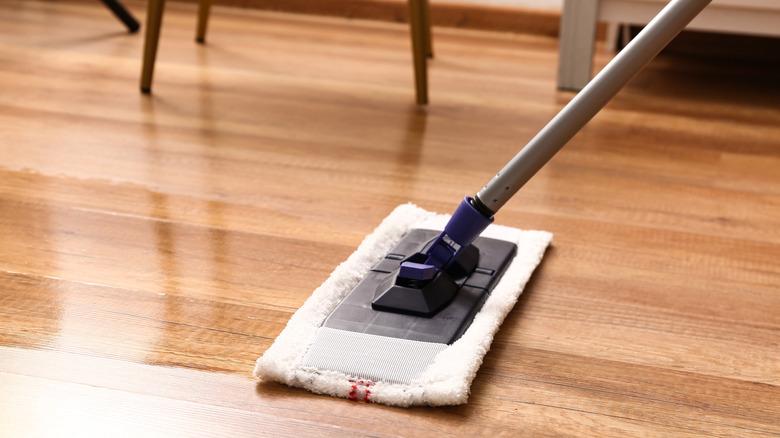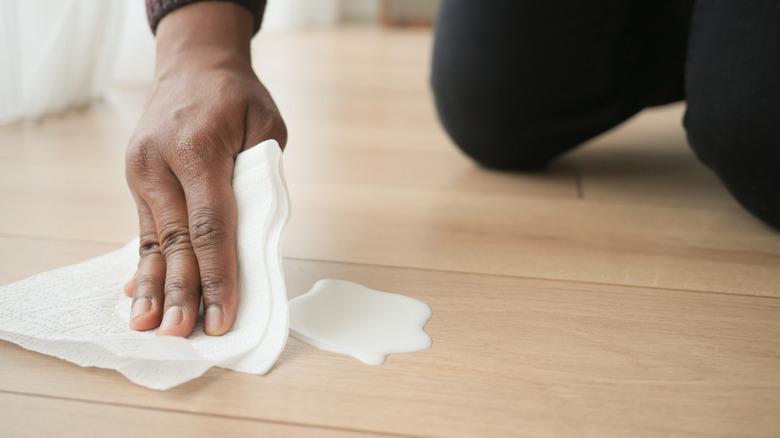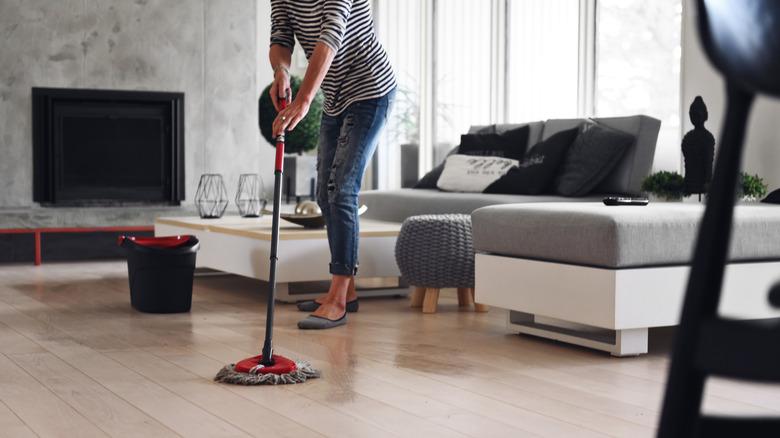The Laminate Flooring Cleaning Mistakes To Avoid At All Costs
Vinyl floors have become a go-to flooring option for many homeowners and landlords because the benefits of are numerous: They're durable, affordable, and thanks to advancements in technology, are now available in a number of styles, textures, and colors. But for all of these major pros, it's very easy to damage these floors if you aren't careful while cleaning. Making mistakes like using abrasive cleaners and tools like ammonia and steel wool, introducing excess moisture and heat with wet mopping or steam vacuuming, and leaving debris and spills on the floor can destroy your vinyl flooring.
If having damaged floors isn't enough of a deterrent on an aesthetic level, keep in mind that replacing these floors is costly, making maintenance important as a homeowner or as a tenant who will be responsible for any damage. Plus, if badly damaged enough, the issues caused by warped vinyl flooring can lead to severe damage to your home. We'll walk you through why these easy cleaning mistakes can be so problematic on vinyl floors, and what to do instead to keep them looking great.
The most common vinyl floor cleaning mistakes
One of the worst mistakes you can make is using an abrasive cleaner on your vinyl floors, be that with chemicals or tools. Even though they're go-to cleaners and disinfectants, using chemicals like bleach and ammonia can quickly wear down the protective layer on vinyl flooring. This can cause discoloration, dullness, or even cracking over time. Similarly, abrasive tools like steel wool or stiff-bristled brushes can scratch the surface, leaving permanent marks that dull the finish.
Secondly, excess moisture and heat can also pose a serious risk to vinyl, causing the planks to lift, bubble, and warp, allowing liquid to accumulate beneath. Not only can this ruin your vinyl flooring, but accumulated moisture is a common cause of mold in the home. One unlucky TikToker @homewithcp, whose account was devoted to super-saturated wet mopping, even alleges that her wet mopping caused damage so severe that she was evicted from her home. That's why it's best to avoid steam cleaning vinyl floors, too, because even though some of the best steam cleaners out there are great on many types of flooring, all of that concentrated heat can make the vinyl planks lift up, making your floors even more susceptible to water damage.
Finally, don't hesitate to soak up any spills when they happen. Vinyl floors are incredibly durable and hard, so cleaning up spills is a breeze with a damp rag, but sometimes you may see a little puddle and decide to deal with it later. That's when issues can arise, as this can cause discoloration and watermarks that aren't super attractive.
How to properly clean vinyl floors
Now that you know all of the things to avoid when cleaning your floors, here's how to do it right. Start by sweeping or vacuuming the floor regularly to remove dust, dirt, and grit. You should do this as needed, typically a few times a week, even if you aren't planning on mopping afterward, to avoid buildup. Be sure to use a soft-bristle broom or a vacuum designed for hard floors to avoid scratching the surface. If you skip this step before mopping, you'll just be pushing mud around with your mop. For regular maintenance, just use a dry mop and vinyl-safe floor cleaning solution — the best cleaning solutions for vinyl are generally gentle.
For deeper cleaning, you can use a damp mop, or you can get down on your hands and knees and use a damp microfiber rag with a pH-neutral cleaner specifically formulated for vinyl, taking care not to add too much water to the situation. Once you're done, use a damp cloth to rinse away excess cleaner if you aren't using a no-rinse formula. You may also want to use a dry towel to pick up any extra moisture to avoid water accumulation. Doing this routine regularly should generally be plenty to keep those vinyl floors looking great and feeling clean, as most vinyl floors don't require waxing.


